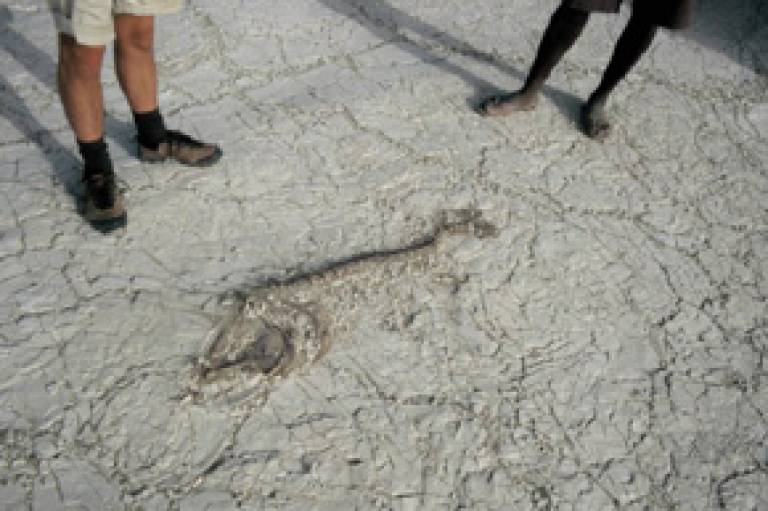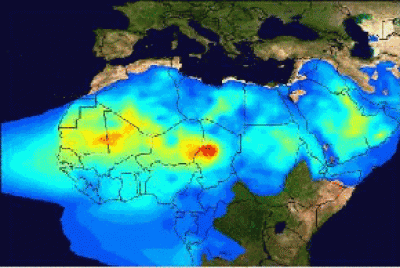Journey to the dustiest place on Earth
13 June 2005
In spring 2005, UCL geographers Professor Andrew Warren and Dr Martin Todd organised the first research team to study on the ground what makes the Bodélé depression, a remote ancient lakebed in northern Chad, the dustiest place on Earth.

There is far more mineral dust in the atmosphere than any other kind. Even the pollutant 'brown cloud' that hangs over parts of China and India cannot compete with the quantity of mineral dust. There is currently huge uncertainty surrounding the effect that dust has on global climate or could have on climate change. If dust reflects solar radiation, it would cool the Earth. If it absorbs solar and terrestrial radiation, it could heat it up.
"The balance of these processes depends on many factors, notably amount, size, shape and colour," explains Dr Todd. "Dust also carries nutrients, such as iron, potassium, phosphorus and calcium and is a major supplier of these to the oceans. Dust from the Bodélé is thought to be the main source of nutrients in Sahelian farming systems, Ghanian forests and forests in the North Eastern Amazon, where it is taken by transatlantic winds."
Most mineral dust comes from very few places; the Bodélé is by far the largest source. Around 6,000 years ago, the Bodélé was covered by Mega-Chad, a huge freshwater lake, then bigger than the present Caspian Sea. The lake gradually desiccated, perhaps disappearing 2,000 years ago. This exposed large areas of diatomite, a deposit formed by freshwater silicious organisms about 2 microns in diameter. Today, this diatomite is the source of the 200-400 million tonnes of dust that is injected into the Harmattan wind, which cloaks Western Africa in dust through the winter and spring.

"When a picture of global dust distribution became available from the data given by the Total Ozone Monitoring Satellite (TOMS), it was blindingly clear that that the Bodélé depression was the dustiest place on Earth," says Dr Todd. "But, despite anxiety about the climatic impact of dust, its crucial contribution to terrestrial and oceanic nutrient budgets, and the Bodélé's unique role in these functions, the only research into the region had been based on the analysis of satellite imagery." With a small grant from the Gilchrist Educational Trust and Royal Geographical Society, the researchers from UCL, Birkbeck College, Salford University and the University of Oxford set off for the three-week Bodélé Dust Experiment (BoDEx 2005).
"The production of dust is dependent on two factors: the erodibility of the surface and the erosivity of the wind," explains Professor Warren. "Without field observations we could only speculate about these factors, or rely on satellite observations without ground truth."
Dry lakes, the world over, are the major sources of mineral dust and in all of them studies have shown that most dust is liberated when sand, carried by strong winds, bombards the surface and chips off the dust. It is different in the Bodélé.
"A low-level jet (LLJ) or strong near-surface wind, coming out of a persistent zone of high pressure in Libya, is funnelled between the Tibesti and Ennedi massifs to the north of the Bodélé," says Professor Warren. "The diatomite is so light that the jet lifts whole flakes of it, which it then grinds down to pellets and then to dust, by flinging them against each other and the hard surface. Some of the pellets are also gathered into huge grey dunes, up to 100 metres high"
Professor Warren continues: "This was the first time the LLJ had been instrumented. We also managed to collect samples for dating successive shorelines of the lake as it desiccated." Dr Todd adds: "NASA kindly lent us instruments to collect the dust and measure its effects in attenuating sunlight, and they are currently analysing our samples for mineralogical and optical properties. These will give insight into the radiative effects of the Bodélé dust on the climate system. These results are important because they enable us to reduce the uncertainty in models of dust emission and its climatic impact."
Images: Top - Diatomite crust on the lakebed. Middle - TOMS aerosol index with the Bodélé in red. Bottom - Base camp after the storm.
To find out more use the links below.
 Close
Close

